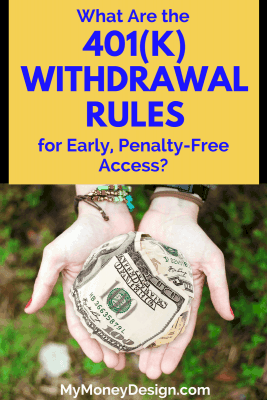The short answer is “yes” – of course!
But the 401(k) withdrawal rules are not without their obstacles.
Remember that the IRS intends these plans to be a way for U.S. employees to save their money for one day when they are ready to retire.
And in exchange, savers get a break on paying the taxes on these earnings now by deferring them to the future when the money is used.
Therefore, because of this design, the rules that come along with making a 401(k) withdrawals can get a little tricky. This is especially true if you need the money in an emergency or if you intend to retire early.
In this post, we’re going to explore your options for getting early and penalty-free access to your money without paying more than you need to.
But first things first, let’s start by going over the basic rules of how and when withdrawals can / can’t be made.
The Basic 401(k) Withdrawal Rules:
The general rule to making a withdrawal from your 401(k) (and most of your other retirement accounts) is that you need to be age 59-1/2 or older.
If you make a withdrawal before this age, then the IRS will impose a 10% penalty tax on top of the normal taxes you’ll already owe for the withdrawal.
Example:
Let’s say you need to withdraw $12,000 for an emergency.
Your income taxes (assuming 25% tax bracket) =$3,000
IRS 10% early withdrawal penalty =$1,200
Net amount to you =$7,800
You should note: Depending on how much money you need to withdraw, it could bump you up into a higher tax bracket. This is because the withdraw is counted as part of your ordinary income for the year (i.e. as if you had earned the money).
So, for example, if you were already near the top end of the 25% tax bracket and you withdraw a few thousand dollars, this might push you up into the 28% tax bracket. That means you’d now owe more money in taxes than you would have normally had to pay!
Complications From Your Employer
When we talk about the age 59-1/2 requirement, this is a standard IRS rule. But your employer may have other rules that cloud the situation.
How can that be?
Remember that a 401(k) plan is something that is administered by your employer. You are just the participant. They get to setup the rules, which funds to invest in, employer matching contributions, etc. And, relevant to this topic, how and when money can come back out. This is generally found in their Summary Plan Description.
Yes, your money is your money. But as long as it’s in their plan, you still need their permission for certain actions.
To better keep things organized, let’s look at this from two perspectives: Those people who are still working and those who are not.
In-Service Withdrawals:
An in-service distribution is when you’re still working for the employer, you’re over the age 59-1/2, and you’d still like to start make withdrawals from your 401(k).
This is what most of these special employer-made rules are designed for, and when most will apply.
For example, you’re working, age 60, and would like to start making withdrawals. You’re over the IRS age of 59-1/2, so no 10% penalty. But your employer might not allow them until age 62 (or some other age). So no withdrawals.
Of course, there is always the optimistic possibility too that they might allow them. You just have to check your plan to know for sure.
Separation From Service:
For most employers, if you no longer work them, then you should have no trouble starting your withdrawals at age 59-1/2 (just as the IRS allows).
But again, this will depend on the employer.
I’ve seen some unique comments online where people have reported “complications” from their former employers such as freezing the account from some period of time, etc.
Again, it’s all up to the rules made by 401(k) plan administrator and the service provider they use.
How to Handle This:
The best policy is always to understand your employer’s 401(k) rules through and through. This again gets back to the Plan Summary Description.
Another (quicker) way to find out the answers is to simply call your 401(k) plan administrator (usually someone from your HR department) and get the details. Ask specific questions from them such as when can I start making withdrawals? If possible, get the answers in writing.
The IRA Rollover Option:
If you’ve separated from your employer and are nervous at all about getting access to your money, I recommend to do a simple IRA Rollover.
This is where you take all of your 401(k) money and move it into an IRA retirement account. It’s incredibly easy to do and often costs nothing.
The advantage to doing is that your IRA is controlled by you. By doing this, you take your employer and their 401(k) rules completely out of the equation.
Plus, an IRA gives you better control over where the plan is invested, what funds you can invest in, and what expenses you’d like to pay.
Penalty-Free Alternatives: 401(k) Hardship Withdrawals
The IRS knows that life isn’t perfect. Stuff happens. And when it does, you’ll probably have a serious one-time need to dip into your money.
These opportunities are called “hardship withdrawals”, and they can be one of the first ways to get money out of your 401(k) without having to pay the 10% penalty.
The IRS defines a hardship as follows:
It must be made on account of an immediate and heavy financial need of the employee and the amount must be necessary to satisfy the financial need. The need of the employee includes the need of the employee’s spouse or dependent. (Reg. §1.401(k)-1(d)(3)(i))
Examples:
- Disability / Certain medical expenses
- Costs relating to the purchase of a principal residence
- Tuition and related educational fees and expenses
- Payments necessary to prevent eviction from, or foreclosure on, a principal residence
- Burial or funeral expenses
- Certain expenses for the repair of damage to the employee’s principal residence
Note that when you take a hardship distribution, you can only withdraw from the contributions portion of your balance, not from the earnings you have made. Also, you won’t be allowed to make any new contributions for at least 6 months.
401(k) Loans
The loan can be as much as 50% of the vested account balance; up to a maximum of $50,000. The IRS requires that you pay yourself back within 5 years. In addition, you would also owe yourself interest on the loan amount as well.
Again: Your employer / plan administrator has to allow them. Don’t always assume they do. At one place I worked, the management made it basically impossible to be able to take out a loan.
For more information, Financial researcher Michael Kitces has a pretty detailed post on how 401(k) loans work.
In my opinion, try to avoid taking out a loan against your 401(k) if at all possible. When you withdraw money, the principal is no longer there to generate the compounding returns that make 401(k) plans so enticing. This puts you at a huge disadvantage for the future.
Early Retirement Options for Penalty-Free 401(k) Withdrawals
Now for the good stuff!
If early retirement is what you seek, then there are a couple of other ways to withdraw your money from a 401(k) penalty-free. They are:
- Separation of service during or after the calendar year in which the participant reached age 55
- Series of substantially equal periodic payments (SEPP)
- Roth IRA Conversion Ladder
- Loan
Let’s touch on each.
Age 55 Rule:
Another little-known rule about 401(k) plans is that if you plan to retire by age 55 or later, the IRS will let you skip on the 10% penalty.
This is sometimes referred to as the 401(k) Age 55 rule. You can read more about it here.
Basically what it says is that if you separate from your employer on or after the year you turn age 55, then you can start making penalty-free withdrawals. Keep in mind “the year you turn age 55” means that if your birthday is in December and you retire 11 months earlier in January, then you can technically be age 54 and still use this rule.
SEPP’s:
SEPP’s are another useful trick for getting your money out of your 401(k) penalty-free before age 59-1/2.
A SEPP is a series of substantially equal periodic payments. This is also sometimes called a 72(t). You can read more about them here.
The general process here is that you elect to start taking withdrawals of a certain amount based on one of three options the IRS gives you. These withdrawals are made penalty-free and must be maintained for at least 5 years or until you turn age 59-1/2 (whichever is longer).
Bankrate has a pretty helpful calculator where you can play with the numbers and calculate out exactly how much you could withdraw using any of the three options.
Roth IRA Conversion Ladder:
If you have a Roth IRA, then this can be a useful technique for moving money out of your 401(k) without penalty.
Basically the process goes:
- Quit your job
- Rollover your traditional 401(k) to a traditional IRA
- Every year convert a portion of your traditional IRA to a Roth IRA
- Wait five years for every amount converted.
- Enjoy penalty-free, tax-free money!
Of course it’s a little bit more tricky than that. You can read a more detailed account of this process here.
Readers – How do you plan to work around the 401(k) withdrawal rules? What kind of challenges do you foresee and how do you plan to overcome them?
Featured image courtesy of Pexels





Great write up and great options, MMD! People often don’t realize how flexible the IRS rules can be–or how restrictive your plan administrator’s rules can be.
Sincerely,
ARB–Angry Retail Banker